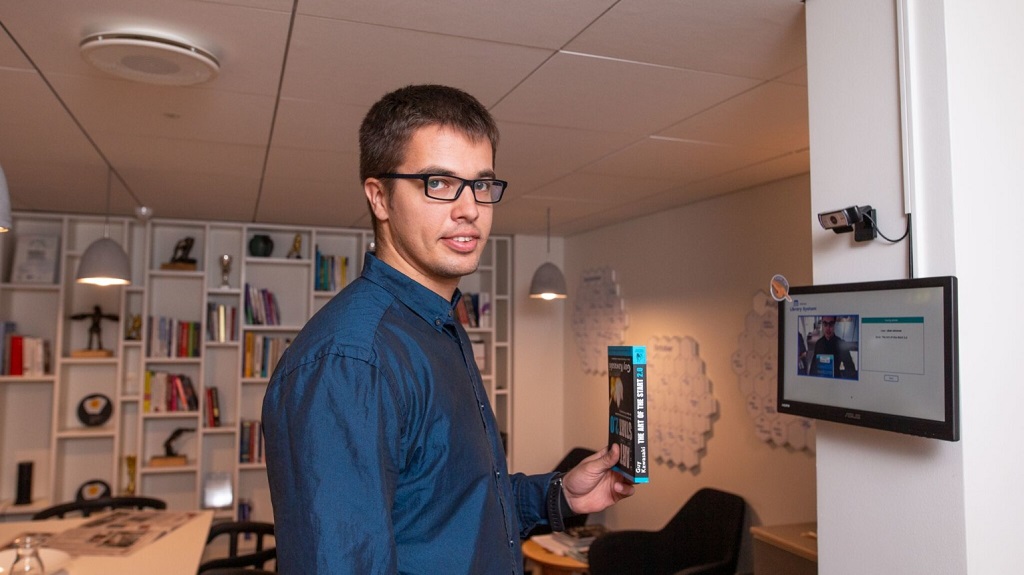Helmes finds more ways to use face recognition – the library was the first to use the possibility. Next, Helmes introduced a two-step access system, based on fingerprint and face recognition, making moving through the doors more convenient and secure. The pilot project developed in Estonia is also planned to be extended to Belarus.
Head of Helmes Internal Systems Development Oliver Stimmer explains how the system developed in collaboration of many people works, how secure it is and in which direction the relevant technology is moving.
FaceStation 2, the face recognition technology used by Helmes won the prize for best product at the renowned technology awards competition Detektor International last year. FaceStation 2 is able to recognise a human face even in dark surroundings, for it uses special three-dimensional pixel intensity on a photo taken by applying infrared illumination and background lighting and fixing the precise points to identify a person.
“Face recognition in the library was developed to make life more comfortable for the users, but the access system is a security solution and therefore we are using a different technology for the latter,” Oliver Stimmer explains. He adds that for lending books a camera that can recognise a face on the basis of a simple photo. However, to grant access the shape of the human face and profile are analysed. Although it is practically impossible to cheat the face recognition system used for access, a fingerprint reader is there to add an extra layer of security for identification.

“All the data – both facial images and fingerprints – are only used in the software of the Helmes access system,” says Stimmer reassuringly, for the algorithm has been developed solely for operating in conjunction with the relevant device and people do not have to worry that their data could be misused.
“No doubt, it is a more secure option in comparison with ordinary access or smart cards that can be left home or lost, for this cannot happen to one’s face or fingers,” Stimmer jokes. Obviously, there have been cases where people have managed to trick the technology and devices, including face recognition systems. “If one really puts one’s mind to it, both people and technology can be cheated, but the system used by Helmes is more secure than, for example, the one used by iPhone X.” Fingerprint readers and the alarm system create additional security for Helmes.
According to Stimmer, security and identification systems based on face recognition are not yet widely used in Estonia and people might have certain prejudices related to this, but it is probably only a matter of time before the new technology becomes ubiquitous.
Face recognition definitely plays an important role in national security and many major countries are already testing such systems. There are regions in China, for example, where CCTV data are used for catching criminals. Similar tests are underway in Europe as well. The FBI database contains photos of more than half the US population already today – take for instance the photos on driver’s licences, which can serve as a basis for finding fugitives and solving crimes.
In addition to increased security and a broader social impact, face recognition brings extremely practical added value in the form of convenience, Stimmer explains. The Smile to Pay option, based on face recognition, introduced last year by the Chinese tech giant Alibaba, was very well received by the clients. It is used in the Kentucky Fried Chicken fast food restaurants: to buy food, you just have to smile into the camera. The face is scanned by using a 3D camera and the payment is made.
But why on earth would you want the fast food restaurant to keep your photo in their database? Maybe because it is easier and safer than to bring your purse? Visa conducted an international survey about the use of biometric data for identification or making payments and 86% of the respondents agreed, citing ease of use and security as reasons.
We can conclude that over time technology has developed the power to make us give up our data voluntarily. The best examples to prove this are Facebook and Google – most people cannot imagine communication and seeking of information without them. Thus, it is probably not going to be in a too distant future that we can pay for our food in a restaurant on the basis of some kind of face recognition technology.
In Helmes, a smile opens the doors already!